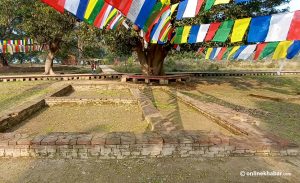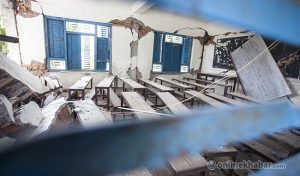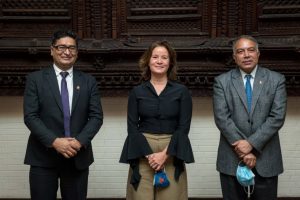On April 25, 2015, the ground shook violently taking down scores of lives as well as destroying historical and religious monuments. Among the 753 monuments collapsed or destroyed, one was Ranipokhari, a historic temple at the heart of Kathmandu.
Ranipokhari (Nhu Pukhu) was constructed by King Pratap Malla in 1670 to mourn the death of his youngest son and console his wife. It had a temple at the centre that was in the Granthakut model. But, it collapsed in the 1934 earthquake and then Prime Minister Juddha Shamsher Rana reconstructed the monument in the Gumbaz style, a common architecture design during the Rana regime.
But, the 2015 earthquake again shook it, requiring the reconstruction. Some months after the quake, authorities launched their efforts to resurrect the historical monument, hoping to complete it as soon as possible. However, it took five years for the pond to have a complete reconstruction thanks to its own shortcomings inviting many controversies.
Here, we explain a complete timeline of those controversies and how the historic monument got back its life.
2016
Initially, Kathmandu Metropolitan City was given the responsibility to design, plan, and oversee the Ranipokhari reconstruction project. It designed a new blueprint, signed a contract with Worldwide Kandel KN KG JV for some Rs 62.9 million, and was set to begin the reconstruction process. But, it was not as easy as the officials had thought.
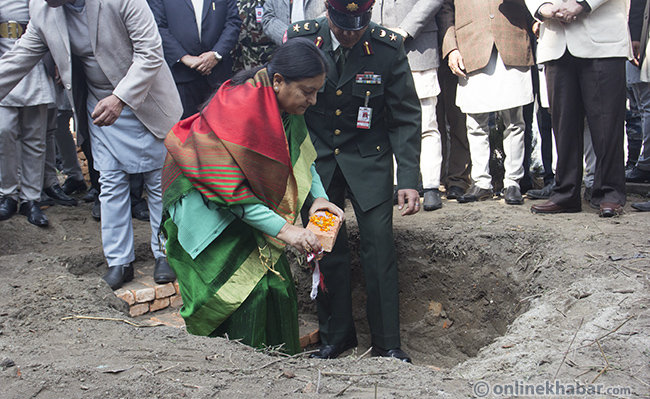
January 16
- The reconstruction formally begins with President Bidya Devi Bhandari laying the foundation stone of the Balgopaleshwar Temple located at the centre of Ranipokhari.
- National Reconstruction Authority (NRA) launches its mega reconstruction campaign starting from Ranipokhari in Kathmandu and Bungamati in Lalitpur.
- The government announces an ambitious plan to renovate Ranipokhari with a whopping Rs 110 million budget.
January 21
- KMC opens the bidding process calling contractors to apply.
April 24
- Rani Pokhari reconstruction begins.
May 2
- KMC drains water out of Ranipokhari using motor pumps, inciting controversies for lack of consultation with locals.
March 29
- Prime Minister KP Sharma Oli expresses dissatisfaction regarding the pace of the national reconstruction mega campaign.
August 23
- Tarpaulin around Ranipokhari was changed from orange to blue raising suspicion that the authorities were hiding something regarding the construction.
- After peeking through the cover, local activist Shailesh Shakya sees a cement pillar erected at Balgopaleshwar temple while water in the pond is dried up and only mud remained. An excavator is ready to dig through the black soil of the same ground.
- On Twitter, Apil KC and Ashish S Rana initiates #AngryPlanner and takes the help of other Facebook pages to organise a demonstration the next day at 5 pm in front of Ranipokhari.
August 24
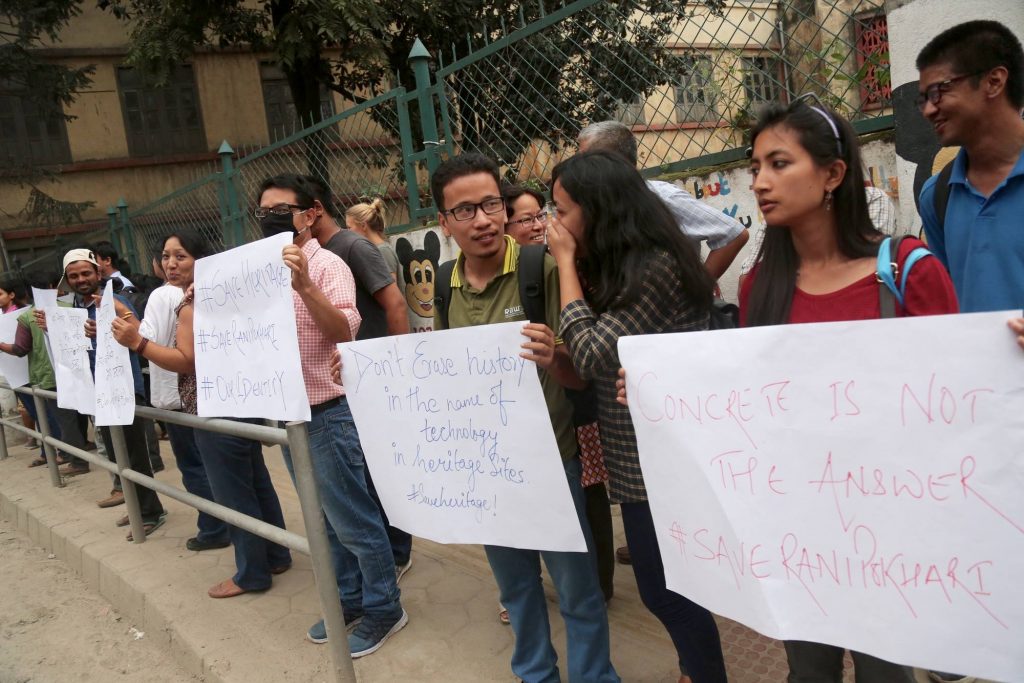
- Responding to the call, hundreds of people gather and form a human chain around the outer premises of the pond. The group of activists, from the day, performs under the Save Heritage campaign.
August 29
- Department of Archaeology bars KMC from reconstructing Balgopaleshwar Temple, for going against the guidelines.
September 1
- UNESCO expresses concerns over the inappropriate reconstruction of the heritage site.
September 7
- Concerns rise on whether the new structure will be able to withstand future earthquakes.
September 18
- KMC announces its decision to stop the reconstruction of Balgopaleshwar temple.
October 22
- The DoA takes over the responsibility of reconstruction of the temple, following a meeting among the NRA, the KMC and the DoA.
December 21
- KMC announces it will develop Ranipokhari as recreational space by merging Shanti Batika and Ratna Park.

2017
January 24
- KMC spokesperson Gyanendra Karki announces a plan to open Ranipokhari as a recreational site, where the public can enter in the evening, after paying a ticket fee.
January 31
- DoA Director-General Bhesh Narayan Dahal informs that preparations have started for the reconstruction of Balgopaleshwar temple.
December 7
- KMC resumes the reconstruction process of Ranipokhari.
December 18
- Heritage activists meet the Kathmandu mayor and submit an appeal to tear down the concrete wall.
December 25
- KMC Mayor Bidya Sundar Shakya claims the task of Ranipokhari reconstruction has been forwarded as per the design approved by the DoA.
- Meanwhile, the KMC’s plan to build an amusement park, a coffee shop and boating facility garner more outrage.
December 26
- Locals, civil society leaders, historians and archaeologists launch a protest claiming the KMC is using modern equipment and materials such as concrete, rods and cement in the reconstruction, thereby altering the traditional appearance.
- Their claims include changing the historic ‘naturally refilling’ pond into a ‘swimming pool’ by applying concrete at the bottom of the pond.
- KMC Deputy Mayor Hari Prabha Khadgi, who reached there, comments that reconstruction works are not being carried away as per standards set by the DoA. Khadgi directs workers to halt the ongoing construction of a wall around the pond.
- Activists padlock the site, followed by Mayor Shakya unlocking it after some hours.
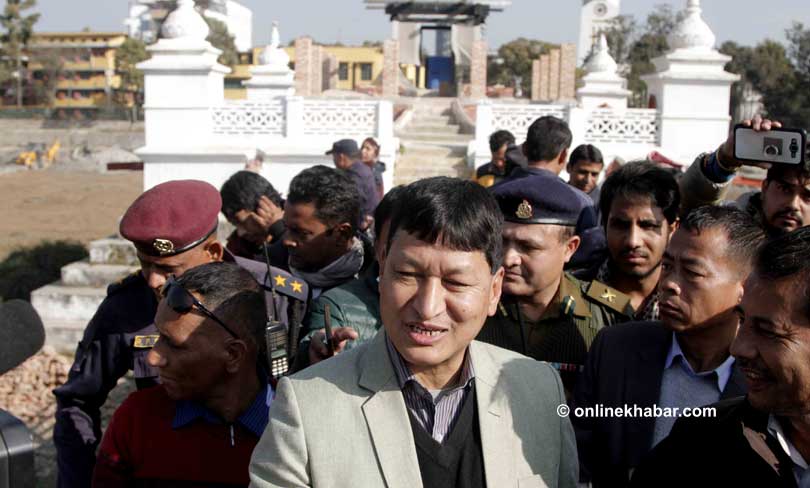
December 27
- DoA directs, via a telephone call, the local government to put reconstruction on hold, after finding that the reconstruction works were against the blueprint as approved by it.
December 28
- Mayor Shakya, Deputy Mayor Khadgi, National Reconstruction Authority Secretary Madhu Sudan Adhikari and Department of Archaeology Director-General Bhesh Narayan Dahal hold a meeting. KMC decides to withdraw from the ongoing reconstruction.
- The meeting forms a panel led by the former chief of the department, Bishnu Raj Karki, and assigns it to work on a new reconstruction plan and submit a report within 15 days.
2018
January 1
- The panel suggests the Ranipokhari premises be excavated before beginning the reconstruction works.
January 17
- An expert committee formed to make suggestions to the KMC on the reconstruction organises a public hearing to discuss its preliminary report with the stakeholders and collects suggestions.
January 21

- The panel submits its report to Mayor Shakya, suggesting the model that the pond be reconstructed in its original form [including Balgopaleswar temple to be built in Granthkut style from Malla era], style and technology.
- It also urges the mayor not to use the historic site as a means of money-making.
February 6
- The KMC asks the DoA for the original design to begin the reconstruction process, but the DoA tells the KMC it does not have any document with the pond’s original design. An official at the department cites they cannot build the entire pond and the temple at its centre on the basis of a single picture, without knowing its measurements and foundation stone.
March 4
- A group of 30 heritage activists file a police complaint against those involved in the Ranipokhari reconstruction. They accuse DoA Senior Division Engineer Sampat Ghimire, KMC Physical Development Department Director Uttar Kumar Regmi and Worldwide Kandel KN KG JV’s Arjun Kandel of misconduct, under the Government Cases Act 2049.
April 5
- A meeting held between Minister for Culture, Tourism and Civil Aviation Rabindra Prasad Adhikari, KMC Mayor Bidya Sundar Shakya and Department of Archaeology Director-General Bhesh Narayan Dahal decides to remove the concrete structures after the pressure from the locals.
April 21
- A dispute emerges among the locals, the DoA, and the KMC. All structures created so far get demolished, citing that the KMC decided to reconstruct the pond along with the other structures again, after removing the modern structures raised so far.
- Subsequently, the KMC terminates its second contract with Worldwide Kandel KN KG JV.
- The decision incurs a loss of Rs 25 million.
- Locals accuse the KMC of misusing their tax money.
June 15
- Bibeksheel Sajha Party leader Ranju Darshana files a right to information application at the KMC and at the DoA, seeking details about the Ranipokhari reconstruction project including a list of expenses, minutes of meetings between the DoA and the KMC, and a list of companies that received tenders by the DoA along with the dates the tenders were agreed.
June 19

- Local residents, heritage activists give the KMC Deputy Mayor grass that they plucked from Ranipokhari in order to draw the attention of the local government which has turned a blind eye to the reconstruction.
- Heritage experts and locals announce they will visit the pond every Saturday to clean the area.
June 23
- The KMC starts removing the concrete walls.
July 17
- The KMC says it will call for tenders for the reconstruction within one week.
July 26
- A meeting held among Deputy Prime Minister and Defence Minister Ishwar Pokharel, Culture Minister Rabindra Adhikari, Department of Archaeology Director-General Bhesh Narayan Dahal, and Kathmandu Metropolitan City Mayor Bidya Sundar Shakya hints at handing over the responsibility of reconstructing Ranipokhari to Nepal Army. The news gets later dismissed by Deputy Mayor Khadgi.
August 21
- The KMC calls for tenders for the reconstruction of Ranipokhari and Balgopaleshwar temple for the third time.
September 27
- The KMC informs about its preparation to start the reconstruction of Ranipokhari once again with a budget of Rs 150 million.
October 15
- Mayor Shakya says all contractors who had applied for the assignment failed to meet requirements set by the local government pushing the project in limbo. It announces it will call for applications for the project once again.
October 18
- NRA Chief Executive Officer Sushil Gyawali claims reconstruction of Rani Pokhari would be completed within a year, in three stages.
November 8
- The Ministry of Culture, Tourism and Civil Aviation asks the DoA to reconsider its decision of rebuilding Ranipokhari in a way that imitates the Gumbaz architecture.

2019
January 8
- Nepal Student Union, the student wing of main opposition party Nepali Congress, organises a football tournament ‘Ranipokhari Football Cup, 2018’ on the bed of the dried pond as a symbolic protest against government lacklusterness.
January 15
- NRA Chairperson and PM KP Oli informs a meeting of the NRA advisory council in Baluwatar that major reconstruction tasks including Dharahara, Ranipokhari and other monuments will not be completed within their five-year tenure.
January 28
- A cabinet meeting decides to give responsibility for the reconstruction of the pond to the NRA and the DoA to build the Balgopaleswar temple.
February 24
- The NRA announces its plans for the reconstruction of Ranipokhari by keeping the pond’s cultural heritage intact. It announces plans for the dried-up area and its surrounding walls.
- The NRA decides to ask the Melamchi Water Supply Board to provide water for the pond.
March 4
- A user committee assigned by the NRA commences reconstruction of the base and the walls of Ranipokhari and mobilises 40 personnel. Reconstruction and beautification of Balgopaleshwar temple will be done by CA Tulasi Construction, a private construction company.
- The NRA forms a reconstruction, monitoring and coordination committee under the coordination of its executive member Chandra Bahadur Shrestha for management and coordination of the reconstruction process.
August 29
- Rani Pokhari Reconstruction Users’ Group meets the monitoring team led by State Minister of Urban Development, Rambir Manandhar, and comprising Mayor of Kathmandu Metropolitan City Bidya Sundar Shakya to brief them about reaching the final stage of its construction.
September 19
- The NRA claims that it will speed up the reconstruction with a target of opening it for the public on Bhaitika (October 29, 2019). The mission is not accomplished.
November 28
- The NRA announces to complete the reconstruction by mid-May 2020. It says the construction of the wall around the pond will be completed by January 14, 2020.
2020
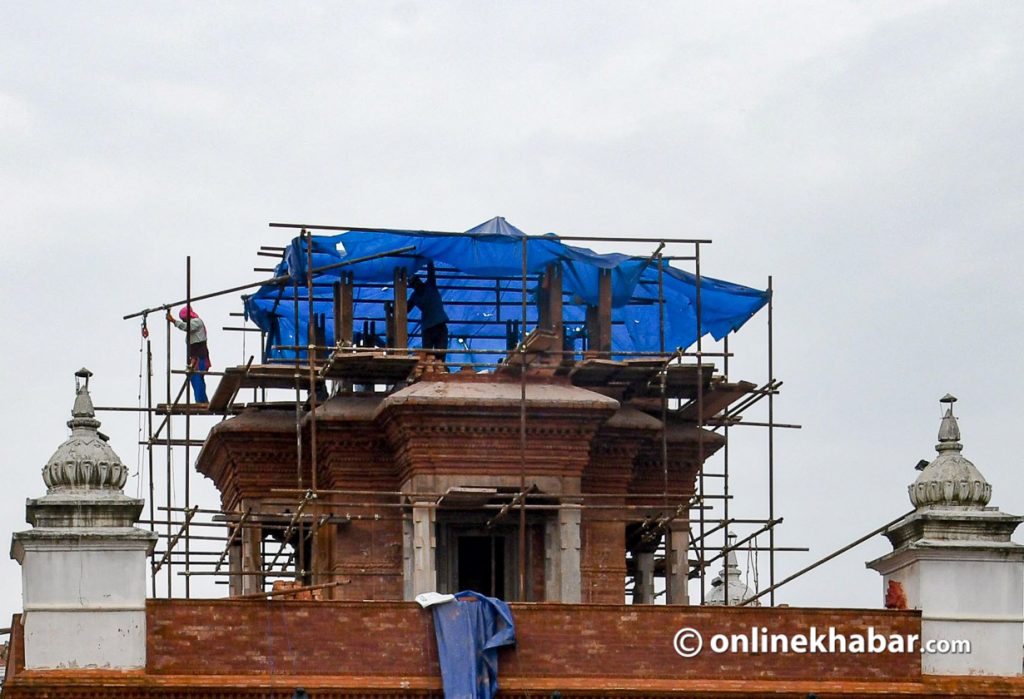
January 16
- The NRA and CA Tulasi Construction say around 80 per cent reconstruction work has completed, adding it will be completed in the next four months.
- Workers complete the work on the embankment of the pond and fill its bottom with black soil as per the archaeological principles.
March 24
- The reconstruction of the pond and premises is stopped following the lockdown across the nation.
April 24
- PM Oli addresses the nation and gives a nod to the resumption of all reconstruction processes including that of Ranipokhari.
May 15
- President Bidya Devi Bhandari, on behalf of the government of Nepal, presents the annual policy and programme for the fiscal year 2020/21, where she shares the plans to complete all reconstruction of historical and archaeological monuments and private houses destroyed in the devastating 2015 earthquake by mid-July 2021.
July 14
- The NRA starts pumping muddy water from borewells. This, in return, invites disapproval from heritage activists, cultural experts and hydrologists.
July 24
- A delegation of heritage activists meet NRA CEO Sushil Gyawali and submit an appeal for a sustainable water management system in Ranipokhari.
July 27
- A Facebook page, #OccupyTundikhel, organises an online public interaction to protest the use of borewell water in Ranipokhari.
August 5
- A meeting held among experts, activists and the NRA at DoA office discusses the use of borewell water.
September 20
- Around 30 million litres of water gets poured into the pond, where 27 million litres were poured a day before, giving the second lease of life to the pond.









